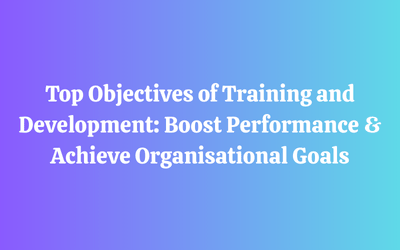Strategic training is a structured approach to workforce development that aligns employee learning with long-term company goals. It goes beyond traditional training to equip employees for evolving job roles, address skill shortages, and maintain a competitive edge. When paired with strong development strategies, it helps businesses foster adaptability, boost performance indicators, and create a future-ready workforce.
This guide explores the concept of strategic training, practical frameworks, and how companies can implement it effectively to support sustainable growth.
What Is Strategic Training?
Strategic training refers to training content designed with a long-term vision—focused on preparing employees to meet organizational objectives. Unlike generic sessions, strategic initiatives rely on training needs assessments to align employee knowledge with evolving market and company demands.
Strategic training prioritizes:
- Business alignment: Linking training activities to company goals and business strategies.
- Customer service: Developing soft skills to enhance employee-customer interactions.
- Performance indicators: Boosting key performance outcomes through targeted instruction.
- Skill shortages: Bridging gaps through reskilling and upskilling initiatives.
- Knowledge management: Capturing and sharing internal expertise to enhance organizational learning.
Frameworks for Strategic Training
Effective training isn’t built on instinct—it’s shaped by proven frameworks that bring structure, alignment, and measurable results to learning initiatives. Below are four widely adopted models that help organizations link employee development directly to business performance.

The 5P Model: A Holistic Blueprint for Learning
The 5P model offers a comprehensive view of how training should be structured, addressing not just what is taught but why, how, and for whom.
- Philosophy: Establishes your organization’s attitude toward learning—is it growth-oriented, performance-driven, or both?
- Policies: Outlines the rules and standards for implementing training—such as eligibility, tracking, and review mechanisms.
- Programs: Encompasses a wide range of initiatives—from technical upskilling to leadership academies and informal “lunch & learn” sessions.
- Practices: Refers to your delivery strategy, whether it’s eLearning, blended learning, or on-the-job training.
- People: Ensures the strategy addresses the needs of diverse employee groups—new hires, tenured staff, and high-potential future leaders.
The Action Research Model: Learning Through Iteration
This model treats training as a continuous improvement cycle rather than a one-time event. It’s especially useful in dynamic environments where agility is critical.
- Start by identifying real business problems and performance gaps.
- Design training interventions that are job-specific and goal-oriented.
- Implement, monitor, and refine based on employee feedback, performance reviews, and real-time data.
This iterative approach helps training evolve with the business and stay aligned with changing needs.
The STEM Model: Bridging L&D and Workforce Planning
The STEM model connects training to broader HR functions like workforce forecasting and talent mobility.
Key elements include:
- Future workforce planning: Predict skills needed for upcoming projects or business expansion.
- Career pathway design: Develop structured mentorships and internal mobility options to retain and grow talent.
- Competency mapping: Align skills across roles and departments to avoid redundancy and close gaps.
This model is ideal for companies preparing for growth or undergoing transformation.
The Business-Embedded Model: Making Training Part of Operations
Unlike models where L&D functions in isolation, this framework fully integrates training into the day-to-day workings of the business.
- Training teams work closely with business units to co-own outcomes.
- Senior leaders and managers actively participate in learning initiatives.
- Programs reflect real business challenges, not just generic skills.
This deep integration ensures that learning is both relevant and results-driven.
Strategic Planning for Training
Before launching any training initiative, it’s essential to start with a strategy that reflects your business objectives. Begin with a needs assessment—not just of technical skills, but of behavioral competencies and performance drivers. Evaluate:
- Current employee capabilities
- Team-level performance indicators
- Organizational goals for the next 12–36 months
Then identify future skills required for business success. For example, will you need more data-savvy employees? Finally, raise awareness internally. Promote programs with targeted internal campaigns, manager endorsements, and LMS notifications to maximize visibility and participation.
Digital tools like Learning Management Systems streamline this process, helping deliver content, track progress, and gather actionable data for continuous improvement.
Identifying Skill Gaps and Learning Needs
To build impactful training, you first need to understand where your workforce stands today and what will be needed tomorrow.
Instead of relying solely on top-down evaluations, use a combination of these methods:
- Performance reviews: Uncover recurring capability gaps.
- Job role analysis: Compare current competencies with evolving role requirements.
- KPI tracking: Tie learning needs directly to business outcomes like sales targets, NPS scores, or error rates.
- Employee input: Gather feedback through surveys and focus groups to increase engagement and training relevance.
Designing and Delivering Strategic Training
Once needs are identified, training programs must be designed to match employee goals and company outcomes.
Effective training design should:
- Strengthen understanding of internal tools, processes, or customer-facing responsibilities.
- Align marketing and branding knowledge with customer experience goals.
- Foster continuous learning via informal formats like “lunch and learn” sessions.
- Support long-term development through structured mentorship and coaching.
Delivery Formats to Consider
- Blended learning: A flexible mix of virtual and in-person sessions
- eLearning: Self-paced modules hosted on an LMS for scalable access
- Job shadowing: Enables experiential learning and skill transfer
- Cross-skilling initiatives: Develop employee flexibility and reduce role dependency
Each format should be matched to the learner’s profile, availability, and the complexity of content.
Fostering Sensitivity, Diversity, and Inclusion
Strategic training isn’t just about skill—it’s also about mindset. Diversity and inclusion training helps create respectful, empathetic, and resilient work environments.
These programs go beyond awareness:
- Cultural sensitivity sessions improve collaboration in global teams.
- Unconscious bias training helps in decision-making and hiring.
- Inclusive communication workshops strengthen employee engagement and psychological safety.
Embedding inclusion into training ensures your workforce is not only capable but also emotionally intelligent and collaborative.
Evaluating the Impact of Training
To ensure your programs are driving real value, you need to track outcomes consistently and align them with business goals.
A well-structured evaluation strategy helps you answer critical questions:
👉 Are learners applying their knowledge?
👉 Is the training translating into performance improvements?
👉 Is the investment delivering measurable ROI?
Here’s how to evaluate effectiveness:
- Define Success Metrics Early
Use metrics such as course completion rates, engagement levels, and knowledge retention scores to gauge immediate outcomes. - Measure On-the-Job Application
Post-training evaluations, 30–60–90 day reviews, and manager feedback can reveal whether the learning is being used in daily tasks. - Track Business Impact
Look at department-level KPIs before and after training. Improvements in productivity, customer satisfaction, or error reduction often signal training effectiveness.
Modern LMS platforms play a key role here. With built-in dashboards and analytics tools, they let you:
- Monitor progress in real time
- Identify weak spots in your programs
- Gather learner feedback at scale
- Calculate ROI based on business results
Beyond the Basics: Long-Term Development Strategies
Strategic training doesn’t stop at onboarding or annual refreshers. It includes long-term initiatives that grow leadership, improve agility, and foster continuous learning.
- Leadership Development Programs
To prepare the next generation of leaders, companies are investing in experiential learning. Effective programs include:
- Real-world simulations that mimic complex business challenges
- Strategic thinking workshops to build decision-making capabilities
- One-on-one coaching tailored to personal growth goals
These experiences equip leaders to handle uncertainty, lead cross-functional teams, and drive innovation.
- Cross-Training for Flexibility
Cross-skilling initiatives train employees to perform multiple roles, which:
- Reduces dependency on specific individuals
- Prevents workflow bottlenecks during absences or transitions
- Promotes collaboration and knowledge-sharing across teams
This also strengthens your succession planning and business continuity strategies.
- Informal Learning: Lunch & Learns
Not all learning has to be formal. Regular “lunch and learn” sessions encourage ongoing knowledge-sharing in a relaxed setting.
These sessions can cover:
- Soft skills like time management or negotiation
- Product updates and use cases
- Compliance reminders or industry trends
Because they’re low-pressure and easy to schedule, they help maintain learning momentum throughout the year.
- Making Training Part of the Culture
For training to be truly strategic, it must become part of your company’s DNA—not an afterthought.
This cultural embedding requires:
- Consistent resource allocation: Budget, tools, and leadership time should be set aside for training year-round.
- Visible leadership support: When leaders participate in and promote learning, employees follow suit.
- Cross-functional participation: Encourage departments to co-own training objectives instead of leaving it to HR or L&D alone.
Over time, a learning culture fosters innovation, resilience, and higher employee satisfaction.
The Role of Learning Technology
Technology is the backbone of scalable, personalized, and data-driven training.
A modern Learning Management System (LMS) supports:
- Blended learning delivery—combining online modules with instructor-led sessions
- Customized learning paths based on job role, skill gaps, or career goals
- Centralized performance tracking to measure progress and outcomes
- Easy HR system integration for seamless data flow and reporting
This makes training more accessible, more measurable, and ultimately, more impactful.
Why Strategic Training Drives Results?
Let’s summarize the key benefits of investing in strategic training and development:
1. Boosts Employee Engagement
Employees who see a clear learning path are more engaged and aligned with company goals.
2. Strengthens Performance
Well-targeted training tied to key performance indicators improves job efficiency and output.
3. Builds Organizational Agility
Strategic training helps businesses respond to market changes, competitor moves, and evolving customer needs.
4. Enhances Customer Service
Soft skills development and scenario-based learning prepare staff to deliver high-quality customer experiences.
5. Aligns Talent with Strategy
By connecting workforce capabilities to long-term goals, training becomes a strategic lever—not just an HR function.
Final Thoughts
Strategic training isn’t just about filling roles—it’s about future-proofing your organization. From targeted development strategies to digital delivery through a learning management system, training programs today must evolve alongside business needs.
Whether you’re planning a lunch and learn series, launching a mentorship program, or refining your performance reviews, every initiative counts when it’s part of a broader plan.
Ready to transform your approach? Start with a needs assessment, build with intent, and align every training investment with your business strategy.
Our News
- AI
- Animations
- Articulate
- Articulate 360
- Articulate Engage
- Articulate Live
- Articulate Presenter
- Articulate Quizmaker
- Articulate Replay
- Articulate Review
- Articulate Storyline
- Articulate Storyline 3
- Articulate Studio
- bite sized learning
- Characters
- Content Library
- Corporate Communication
- E-Learning
- e-Learning Authoring Tools
- Employee Engagement
- Game-Based Learning
- Gamification
- Gamiflexer
- Go Sales
- Healthcare
- Instructional Design
- Interactivity
- Knowledge Transfer
- L&D Trends
- Learning
- Learning & Development
- Learning Experience platform
- Learning Management System
- LMS
- LXP
- Microlearning
- mLearning
- Mobile Learning
- Nugget Learning
- Online Training
- Peek
- Performance Support
- Preso
- Quiz and Assessment Platform
- Replay 360
- Rise
- SCORM
- Screen Capture
- Software
- Storyline 360
- Studio 360
- Training Management
- Trainings
- Uncategorized




